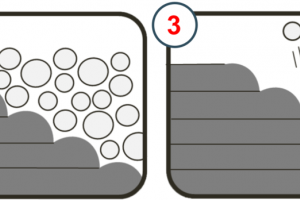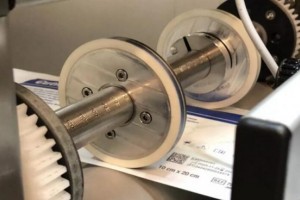塑料作为一种高分子的化合物有各种各样的处理方法方法。每种方法都有其优点和缺点,更适合于特定的应用。接下来我们通过相关有趣的动图看看他们是如何被加工的!
@There are a variety of methods used to process plastic. Each method has its advantages and disadvantages and are better suited for specific applications. There are various plastic processing techniques featured with their relevant animations.
注塑机
Injection Molding


注塑是一种通过将材料注射到模具中制造零件的制造方法。加工塑料的主要方法是注射成型。在这个过程中,塑料被放置到料斗,然后料斗将塑料加热注入,它是通过一长的腔室与一个往复螺杆推压。之后,它被软化成流体状态。喷嘴位于腔室的末端,流体塑料通过喷嘴强制冷却,闭合模具。当塑料冷却和固化时,半成品从压机中退出。
@Injection molding is a manufacturing process for producing parts by injecting material into a mold. The main method used for processing plastic is injection molding. With this process, the plastic is placed into a hopper. The hopper then feeds the plastic into a heated injection unit, where it is pushed through a long chamber with a reciprocating screw. Here, it is softened to a fluid state. A nozzle is located at the end of the chamber. The fluid plastic is forced through the nozzle into a cold, closed mold. The halves of the mold are held shut with a system of clamps. When the plastic is cooled and solidified, the halves open and the finished product is ejected from the press.

塑料挤出
Plastic Extrusion

塑料挤压是一个大批量制造的方法,其中塑料原材料被熔化形成连续的轮廓。挤出的过程通常是用来制造如膜,连续片材,管,型材,棒材,外套丝,长丝,线,和电缆。和注塑机一起,干燥的塑料放置到料斗并送入一个长的加热室中。在腔室的末端,材料被压出一个小开口,或在所需的最终产品的形状的模具。塑料离开模具后,它被放置在传送带上冷却。鼓风机有时会在此过程被使用,帮助其冷却。
@Plastics extrusion is a high volume manufacturing process in which raw plastic material is melted and formed into a continuous profile. The process of extrusion is usually used to make products such as film, continuous sheeting, tubes, profile shapes, rods, coat wire, filaments, cords, and cables. As with injection molding, dry plastic material is placed into a hopper and fed into a long heating chamber. At the end of the chamber, however, the material is forced out of a small opening or a die in the shape of the desired finished product. As the plastic exits the die, it is placed on a conveyor belt where it is allowed to cool. Blowers are sometimes used to aid in this process, or the product may be immersed in water to help it cool.
吹塑机
Blow Molding


吹塑是制造空心塑料制品的成型方法,是借助气体压力使闭合在模具型腔中的处于类橡胶态的型坯吹胀成为中空制品的二次成型技术。
@Stretch Blow Molding process is mainly used when the plastic product that needs to be created should be hollow. A molten tube is created with blow molding byusing compressed air.Variations of blow molding include injection, injection-stretch, and extrusion blow molding.
热成型
Thermoforming

将热塑性塑料片材加工成各种制品的一种较特殊的塑料加工方法。片材夹在框架上加热到软化状态,在外力作用下,使其紧贴模具的型面,以取得与型面相仿的形状。冷却定型后,经修整即成制品。此过程也用于橡胶加工。近年来,热成型已取得新的进展,例如从挤出片材到热成型的连续生产技术。
@Thermoforming is a manufacturing process where a plastic sheet is heated to a pliable forming temperature, formed to a specific part shape in a mold, and trimmed to create a usable product. The sheet, or film when referring to thinner gauges and certain material types, is heated in an oven to a high-enough temperature that it can be stretched into or onto a mold and cooled to a finished shape. The second animation shows the twin sheet thermoforming process whereby two individual components are fused together through the application of tremendous pressure which forces two molds together, thereby fusing the materials together.
第二动画显示了双片热成型工艺。
@The second animation shows the twin sheet thermoforming process whereby two individual components are fused together through the application of tremendous pressure which forces two molds together, thereby fusing the materials together.

压缩成形
Compression Molding

压缩成型是热固性材料中最常用的方法,通常不用于热塑性塑料。此过程中,该材料被挤压成所需的形状。塑料模塑粉和其他材料添加到混合物中,以产生特殊的品质。当模具关闭并加热,该材料经过了硬化,形成其期望的形状。温度,压力和过程中使用的时间长度取决于所期望的结果。
@Compression molding is the most common process used with thermosetting materials and is usually not used for thermoplastics. With this process, the material is squeezed into its desired shape with the help of pressure and heat. Plastic molding powder and other materials are added to the mix in order to create special qualities or to strengthen the final product. When the mold is closed and heated, the material goes through a chemical change that causes it to harden into its desired shape. The amount temperature, amount of pressure, and length of time utilized during the process depends on the desired outcome.
轧光
Calendering


又称压光。重革整理的最后一道工序。利用纤维在混热条件下的可塑性将织物表面轧平或轧出平行的细密斜线,以增进织物光泽的整理过程。材料被送入之后,加热并熔化,然后成形为片或膜,然后冷却并卷起。最常用压延材料是聚氯乙烯。
@Calendering is a continuous process which works in much the same way as anold-fashioned clothes mangle. For plastics, there are usually four heated rollers of different sizes rotating at slightly different speeds. The material is fed into these rollers, heated and melted, then shaped into a sheet or film. This is then cooled and rolled up. The sheets can be mono-oriented during this process. The most commonly calendered material is PVC.
挤压成型
Pultrusion

挤压成型,坯料在三向不均匀压应力作用下,从模具的孔口或缝隙挤出使之横截面积减小长度增加,成为所需制品的加工方法叫挤压,坯料的这种加工叫挤压成型。
@Pultrusion is similar to extrusion in that it produces continuous cross-sectional profiles. While extrusion relies on press to push unreinforced thermoplastic materials through a short die, pultrusion pulls a variety of reinforced fibers, wetted by thermosetting and/or some thermoplastic resins, through a heated die. Polymerization of the resin occurs as the wetted fibers pass through the die, forming a continuous, rigid profile corresponding to the orifice shape.
真空成型
Vacuum Forming


真空成型(Vacuum Forming)常称为吸塑,是一种塑料加工工艺,主要原理是将平展的塑料硬片材加热变软后,采用真空吸附于模具表面,冷却后成型,广泛用于塑料包装、灯饰、广告、装饰等行业。
@Vacuum forming is a simplified version of thermoforming, whereby a sheet of plastic is heated to a forming temperature, stretched onto a convex, or into a concave, single-surface mold, and forced against the mold by a vacuum (suction of air).
旋转成型
Rotational Molding

滚塑成型又称旋塑、旋转成型、旋转模塑、旋转铸塑、回转成型等。滚塑成型工艺是先将塑料原料加入模具中,然后模具沿两垂直轴不断旋转并使之加热,使模内的塑料原料在重力和热能的作用下,逐渐均匀地涂布、熔融粘附于模腔的整个表面上,成型为所需要的形状,再经冷却定型、脱模,最后获得制品。
@Rotational molding is an extremely popular and well-used process for producing items that are usually hollow. The mold is closed and then spun both vertically and horizontally and moved into an oven. As the powder starts to melt and the mold continues rotating, it is flung onto the walls of the mold by centrifugal force where it forms a skin. After a fixed period, the mold is removed from the oven and allowed to cool carefully to avoid the product shrinking or warping. It's most often used for very large articles which are usually made in small quantities.





 浙公网安备: 33028102000314号
浙公网安备: 33028102000314号